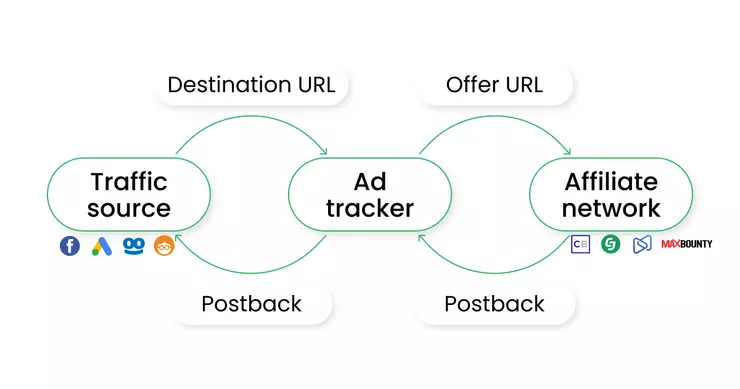
Postback URL Tracking For Affiliate Marketers
If you are involved in affiliate marketing, you have to face the pain of postback tracking. Even though it’s a pretty hard tracking method for understanding, it has a lot of benefits for your advertising strategy.
If you still don’t know how to set up Postback URL tracking, this article is right for you. We’ll dive into the definition of postback URL, why you need it as an affiliate marketer, and what kind of benefits you receive when choosing postback tracking over other methods (pixel-based, mostly).
What is a Postback URL?
In a nutshell, postbacks are a special type of URLs that help to pass conversions on a server-side.
There is a variety of names that postbacks have: s2s, callback, or cookieless tracking. The point is yet the same: it is a way to pass information about conversions (and other target actions for your service or product) without cookies and tracking pixels. This makes it a future-proof and safe way for conversion tracking.
On-Demand Video Course On Native Advertising
Boost your ROAS with native ads. Enroll now with our limited 30% discount.

When using a postback URL, conversion data is passed directly from the “thank you page” to an affiliate network, and the other way around.
Why do you need postback URL tracking as an affiliate marketer?
There are 2 main reasons why you can’t live without postback URL tracking as an affiliate marketer:
1. Seamless tracking of conversions at the merchant website
With rising concern about security and privacy, merchants’ “thank you page” is harder to reach. Earlier you needed to install your tracking pixel on a “thank you page” in order to receive conversion data. However, Postback URL helps you do all the tracking through this special URL. Therefore, receive accurate conversion data about the amazing job that you’ve done with bringing conversions and be able to share/discuss those results with the merchant.
2. The cookieless world is more real than you might think
We all have heard scary headlines about the death of third-party cookies. The cookieless advertising is real and we recommend you to prepare for it as soon as possible.
Postback URL tracking allows you to track all the conversions via server-side which is a cookieless way. This tracking method ensures that your marketing activities won’t be damaged by incorrect data, blockage of your pixels, etc.
If you want to learn more about the cookieless future of advertising, check out the video from our partners with a great explanation on a subject!
What are the benefits of a postback URL over a tracking pixel?
There are several reasons why advertisers often choose postbacks over tracking pixels:
1. Tracking pixels might provide inaccurate data
Because of the well-known cookieless future concern, pixels get easily blocked by browsers or ad blockers. Which may leave you with inaccurate data about the conversions that your efforts brought.
On the contrary, postback tracking ensures that you are compliant with all the privacy updates, as well as provides accuracy when working with affiliate networks and merchants.
2. Affiliate networks might not support pixel tracking
Affiliate networks now take postback URL tracking as a standard. As it makes the tracking process more transparent and accurate, tracking pixels might not be accepted by the affiliate network of your choice.
Postback URL has become a common practice for the affiliate marketing world, and affiliate networks fully support this method.
How a postback URL works
If you are just starting out with ad tracking and are not familiar with all the tracking terms, we recommend first checking the guide on ad tracking.
If tracking parameters and click IDs don’t scare you, let’s learn about the peculiarities of postback URL tracking.
The usual workflow for postback URLs looks the following way:
- A user clicks on an affiliate link that already contains tracking parameters;
- They are being redirected to the landing page / merchant’s website and make a purchase;
- When a conversion happens, a postback URL sends the data back to the tracking software and authenticates that this conversion came from a particular affiliate;
- Tracking software activates a traffic source postback URL and reports conversion to the traffic source.

Tracking parameters in a postback URL
The important part of any postback URL are tracking parameters. They are responsible for collecting the data about the interactions of the user with the product you promote.
There is a bunch of parameters that you can use, and they are defined by the affiliate network and the tracking software of your choice. But here are a few that you should not miss to ensure that your postback tracking is delivering reliable data:
Cid — this parameter is responsible for sending the click ID of the conversion made. Click ID is a unique identifier that helps find a particular user who made the conversion. Without click ID postback tracking won’t be possible.
Payout — this parameter holds the value of the revenue amount that has to be paid for the performed conversion. Even though it’s an optional parameter, it’s a very nice one to use for affiliate marketers.
Campaign ID — this one sends the numeric ID of your advertising campaign. Also, an optional parameter that helps keep track of the campaigns’ performance
There are a few other parameters you can use for your analytics. You just need to check with your affiliate network and tracking software.
Setting up postback URL with the help of affiliate tracking software
Setting up postback URL tracking can be overwhelming, however, there are special tools that make it easy.
On-Demand Video Course On Native Advertising
Boost your ROAS with native ads. Enroll now with our limited 30% discount.

_Affiliate tracking software helps to perform ad tracking and conversion attribution for your campaigns. It collects all the data about the campaign performance in one tool and helps to connect affiliate networks with merchants._
The right tool should offer out-of-the-box integrations with all the popular affiliate networks, allowing your to optimize your performance by using safe tracking methods with no-tech skills.
One of the go-to tools for simplifying tracking in the affiliate marketing world is RedTrack.
It’s a proven source of insights that performs all the hard tracking work for you. Some of the benefits of using RedTrack are:
- Integration with 20+ affiliate networks;
- Postback URL (s2s) conversion tracking;
- Facebook CAPI support;
- Automation & Optimization functionality and many more.
If you haven’t given RedTrack a try yet, consider taking a 14-day free trial or book a demo to check what the platform has to offer.

 Feed
Feed


